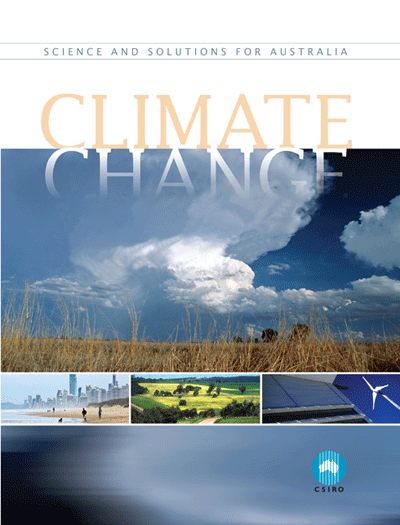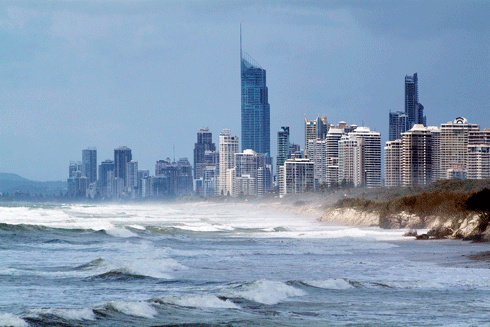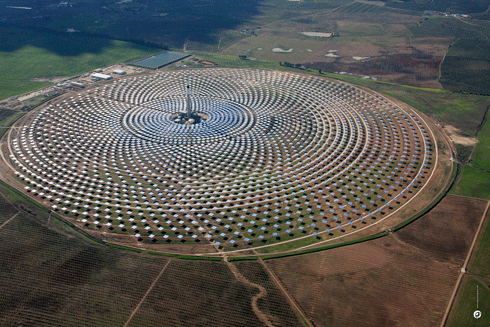
|
Published: 6 April 2011
Climate change science: a new synthesis for Australia
How does today’s climate change differ from similar events in the past? What does the best science tell us about where we are heading? And how does research suggest we should respond to the challenges? CSIRO summarises the key peer-reviewed research in an easy-to-read, free-access, online book – Climate Change: Science and Solutions for Australia.
Climate change has been called the greatest environmental challenge of our time. It also has proved one of the greatest communication challenges.
The breadth and depth of climate change science is reflected in the contributions of more than 2500 scientific expert reviewers, 800 authors, and 450 lead authors from many disciplines contributed to the 2007 Intergovernmental Panel on Climate Change (IPCC) 4th Assessment reports.1
Australians now have access to a plain English summary of the science in the form of a free online book published by CSIRO.
The 168-page book, Climate Change: Science and Solutions for Australia, is a synthesis of the latest science from an Australian perspective, drawing on peer-reviewed literature involving thousands of researchers.

|
|
Climate Change is available online, free of charge at www.csiro.au/Climate-Change-Book |
CSIRO Chief Executive, Dr Megan Clark, says the book provides ‘a bridge from the peer-reviewed scientific literature to a broader audience of society while providing the depth of science that this complex issue demands and deserves’.
Leading figures involved in the public climate change debate agree on the need for a book that steps ordinary Australians through the complexity of the science.
Professor Will Steffen of the ANU was recently appointed to the nation’s new Climate Change Commission.
‘With so much misinformation on climate change flying around in the media and the public these days, a summary of the latest peer-reviewed science by a group of Australia's leading scientists is a welcome addition to the discourse,’ he comments.
‘The book reiterates the importance of world-class research institutions like CSIRO in providing the Australian public and politicians with reliable information on climate change from researchers with impeccable credentials.’
Anna Skarbek is Executive Director of ClimateWorks, a non-profit group supported by Monash University and The Myer Foundation that researches ‘low-carbon prosperity’ solutions. She is pleased to see a summary of the science made publicly available online.
‘It is critical that we continue to be guided by peer-reviewed science, and I welcome this effort to help make it accessible,’ she says.
Dr Bruce Mapstone, Chief of CSIRO Marine and Atmospheric Research wrote the book’s introduction. He says Climate Change provides details and discussions that supplement earlier scientific summaries provided by CSIRO, the Bureau of Meteorology, and the Australian Academy of Science.2–4
‘The book explains what this extra detail about the science is telling us, and what are some of the main uncertainties in the science,’ says Dr Mapstone.
‘It reflects the current state of knowledge up to, and including, last year, so key work published since the 2007 IPCC assessment report will be captured in each of the chapters.’
Climate Change points out that despite some areas of uncertainty in the science, climate scientists agree overwhelmingly that:
-
the climate has been changing over the past century or so at a rate faster than recorded for a very long time in geological history
-
a clear link exists between atmospheric greenhouse gases and global temperature, consistent with the laws of physics and chemistry
-
increasing levels of greenhouse gases – mainly CO2 – in the atmosphere are primary causes of global warming and acidification of the global ocean, and
-
emissions from human activities are primarily responsible for most of the increase in greenhouse gases in the atmosphere.
The book highlights important distinctions between climate and weather, and climate variability and climate change, which are often overlooked in the public debate.
Climate variability refers to year-to-year variations or ‘noise’ in average conditions, which mean that some summers, for example, are hotter or wetter than the long term average. Climate change refers to long term trends in climate over years or decades, on which year-to-year climate variability is superimposed.
Dr Mapstone says he hopes Climate Change will help readers understand why scientists attribute recent changes in climate mainly to rapid rises in greenhouse gases driven by human activity.
‘No one yet has come up with a credible, alternative explanation for why these recent rapid changes in climate are occurring,’ he says. ‘We can reproduce in climate models recent climate dynamics very well only if we include anthropogenic emissions of greenhouse gases.
‘The sums of climate physics and chemistry just don’t add up to what we have seen happening if the human contributions of greenhouse gasses to the atmosphere are not included.’
Other scientific insights from the latest science summarised in the book include:
-
some degree of climate change is ‘locked in’ as a result of past greenhouse gas emissions, so we will need to adapt on a far more extensive scale than is currently occurring
-
energy saving technologies, demand reduction and distributed power generation will help to lower national carbon emissions
-
agriculture and forestry hold great potential for mitigating greenhouse gas emissions through afforestation, soil-carbon management, and better management of livestock and cropping emissions, and
-
action within the next decade to lower greenhouse gas emissions will reduce the probability and severity of climate change impacts in future decades.
‘Adaptation on a scale far more extensive than is currently occurring will be essential in all walks of life if we are to limit the social, economic and environmental impacts,’ say Climate Change editors Drs Helen Cleugh, Mark Stafford Smith, Michael Battaglia and Paul Graham.
‘Australia’s greatest need is for low-emissions technologies that are competitively priced, resilient and flexible enough to cope with a range of possible future energy challenges and demands.’
Dr Peta Ashworth, another of the book’s 20 authors, says it’s not just industry and government that will be leading mitigation and adaptation efforts. ‘The Australian public will have a powerful influence over the pace and extent of national climate change mitigation strategies.
‘There is considerable scope for individuals to reduce their own carbon footprint and there is growing public support for transition to a green economy,’ she states.
‘Face to face communication and knowledge sharing to overcome the gaps in understanding are critical.’
As well as the free online version, CSIRO will be distributing copies of Climate Change to key decision makers around the country.
More information
Climate Change: Science and Solutions for Australia can be downloaded for free at: www.csiro.au/Climate-Change-Book
1 The 2007 synthesis report is the most recent in the series; the 5th report, due in 2014, is likely to be as lengthy and complex as its predecessors due to the scope of climate change science and impacts.
2 The science of tackling climate change (2009) CSIRO, 32pp, www.csiro.au/resources/Tackling-climate-change.html
3 State of the climate: snapshots, CSIRO & Bureau of Meteorology occasional series, www.csiro.au/resources/State-of-the-Climate.html
4 Science – facts and fiction, Australian Dept Climate Change & Energy Efficiency, www.climatechange.gov.au/en/climate-change/myths/science.aspx




